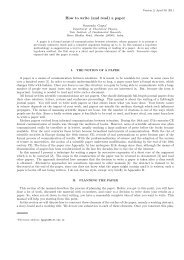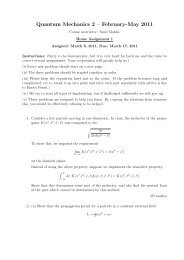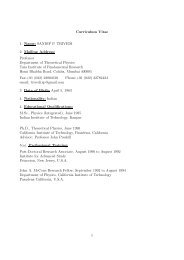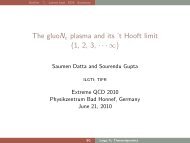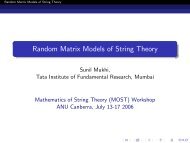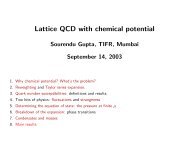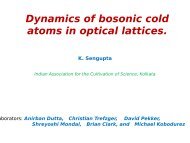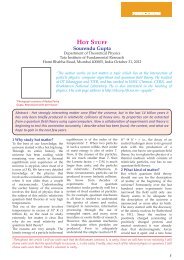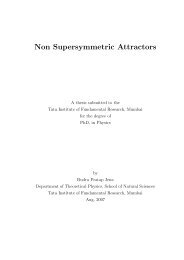A report on an experiment I did of doing electrophoresis with proteins
A report on an experiment I did of doing electrophoresis with proteins
A report on an experiment I did of doing electrophoresis with proteins
Create successful ePaper yourself
Turn your PDF publications into a flip-book with our unique Google optimized e-Paper software.
20<br />
IV.<br />
CONCLUSION<br />
This <strong>experiment</strong> <strong>an</strong>d the associated <strong>an</strong>alysis shows a careful <strong>an</strong>alysis <strong>of</strong> the limitati<strong>on</strong>s <strong>of</strong> being able predict mass<br />
<strong>of</strong> a protein in a given sample by looking at intensitities <strong>of</strong> dye stains. In the process the use <strong>of</strong> running a serial<br />
diluti<strong>on</strong> <strong>of</strong> the protein soluti<strong>on</strong> through <strong>an</strong> SDS-PAGE <strong>electrophoresis</strong> set-up is found to be helpful to find out the<br />
dependence <strong>of</strong> the intensity <strong>of</strong> the stain <strong>on</strong> the mass. Analysis <strong>of</strong> that shows that though intensities <strong>of</strong> stain seem to<br />
show not so regular behaviour <strong>with</strong> the mass <strong>of</strong> the protein the intensities show a power-law fall <strong>with</strong> masses <strong>of</strong> the<br />
protein <strong>with</strong> exp<strong>on</strong>ents <strong>an</strong>d pre-factors which seem robust across <strong>experiment</strong>s. Hence as <strong>an</strong> end result <strong>on</strong>e c<strong>an</strong> get<br />
st<strong>an</strong>dardizati<strong>on</strong> curves which c<strong>an</strong> be used to either predict masses <strong>of</strong> <strong>proteins</strong> in a r<strong>an</strong>dom soluti<strong>on</strong> if in <strong>on</strong>e sample<br />
the mass is exactly known or ratios <strong>of</strong> masses in different samples in <strong>an</strong>y case.<br />
Doing <strong>of</strong> the <strong>experiment</strong> also introduced me to new <strong>experiment</strong>al skills involved in h<strong>an</strong>dling microliters <strong>of</strong> fluids<br />
<strong>an</strong>d <strong>doing</strong> image <strong>an</strong>alysis.<br />
V. ACKNOWLEDGEMENT<br />
I would like to express my deep gratitude for Pr<strong>of</strong>.Roop Mallick for letting me intern in his laboratory for these 2<br />
m<strong>on</strong>ths <strong>an</strong>d for giving me immense freedom to explore various possibilities <strong>an</strong>d suggesting crucial checks <strong>an</strong>d cauti<strong>on</strong>s<br />
while <strong>an</strong>alyzing the results.<br />
I was fortunate to receive <strong>an</strong>d extraordinary amount <strong>of</strong> help from Pradeep. It was heartening to see him even<br />
compromise <strong>on</strong> his examinati<strong>on</strong> peparati<strong>on</strong>s <strong>an</strong>d his own research to help me <strong>with</strong> every <strong>experiment</strong> that I tried <strong>an</strong>d<br />
especially for patiently teaching me all the basic techniques. For every problem in the laboratory I found Pradeep’s<br />
kind help to save the day.<br />
Further I would like to th<strong>an</strong>k Ashim for helping me through a Western Blotting <strong>experiment</strong> <strong>an</strong>d also for his timely<br />
<strong>an</strong>d sharp insights <strong>with</strong> feasibility <strong>of</strong> <strong>experiment</strong>s.<br />
I would like to th<strong>an</strong>k Ravi for letting me use some <strong>of</strong> the soluti<strong>on</strong>s <strong>of</strong> Actin protein which he al<strong>on</strong>g <strong>with</strong> the others<br />
had painstakingly extracted <strong>an</strong>d purified.<br />
I would like to th<strong>an</strong>k members <strong>of</strong> Pr<strong>of</strong>.Ulhas Kolthur’s lab for letting me use their water heater <strong>an</strong>d <strong>an</strong>tibodies ever<br />
so <strong>of</strong>ten. Once I also had to use the water bath in Pr<strong>of</strong>.Shubha Tole’s lab. Th<strong>an</strong>ks are also due to Pr<strong>of</strong>. Gotam. K.<br />
Jarori’s lab for letting me use their 30% Acrylamide soluti<strong>on</strong>s.<br />
Lastly I would like to th<strong>an</strong>k the Suject Board <strong>of</strong> Physics at TIFR for providing this enriching experience.<br />
5 “Electrobloting <strong>of</strong> <strong>proteins</strong> from polyacrylamide gels” by Michael.J.Dunn, published in“Protein Purificati<strong>on</strong> Protocols” edited<br />
by Paul Cutler<br />
5 “Using Antibodies” by Ed Harlow <strong>an</strong>d David L<strong>an</strong>e<br />
5 “Disc Electrophoresis-I” by Le<strong>on</strong>ard Ornstein<br />
5 “Isotachophoresis-Some fundamental aspects” by Jozef Le<strong>on</strong>ardus Beckers<br />
5 Wikipedia






